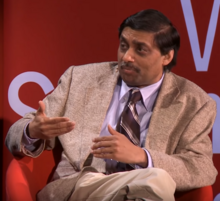Indian physicist
Samir Dayal Mathur is a theoretical physicist who specializes in string theory and black hole physics.
Career
Teaching
Mathur is a professor in the Department of Physics at Ohio State University and a member of the University's High Energy Theory Group. He was a faculty member at Massachusetts Institute of Technology from 1991–99 and held postdoctoral positions at Harvard University and the Tata Institute of Fundamental Research.[1]
Research
Mathur's research is focused on string theory, black holes, the AdS/CFT correspondence, and cosmology. He is best known for developing the Fuzzball conjecture as a resolution of the black hole information paradox. The Fuzzball conjecture asserts that the fundamental description of black holes is given by a quantum bound state of matter which has the same size as the corresponding classical black hole.[2] This quantum bound state replaces the event horizon and singularity, and the classical black hole metric is claimed to be an approximate effective description.[3]
In 2009 Mathur published a strong version of the black hole information paradox, strengthening Stephen Hawking's original version by demonstrating that small local corrections to Hawking's semiclassical analysis cannot restore unitarity.[4] This result was obtained by applying Strong Subadditivity of Quantum Entropy to the evaporation of Hawking radiation.[4] This led to a renewed interest in the information paradox and the development of the 2012 black hole firewall paradox.[5][6][7]
